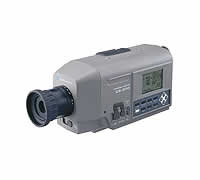Konica Minolta CS-200 Luminance Color Meters
Konica Minolta Updated: 2008-12-24 RSS
CS-200 ChromaMeter measures luminance and chromaticity of light emitting products as diverse as large plasma displays, compact LCDs and LEDs, outdoor screens, high pressure lamps, and instrument panels.
CS-200 is an instrument that enables highly accurate luminance and chromaticity measurements, comparable to those of the spectroscopic type of instrument while maintaining the simplicity, operability, and competitive price of the tristimulus type.
The CS-200 features 40 sensors and performs calculations using the spectral sensitivity characteristics (colour-matching functions) corresponding to the sensitivity of human eye. With this newly developed spectral fitting method, tristimulus values (XYZ for red, green, and blue) with a far higher accuracy than those of conventional tristimulus colorimeters can be obtained, providing excellent accuracy.
Measurements over a wide range of luminance levels from a low luminance of 0.01 cd/m2 through high luminance of 20,000,000cd/m2 (with measuring angle of 0.1°) can be done.
Three measuring angles can be selected: 1°, 0.2°, and 0.1°. The measuring angle can be switched according to the measurement target, ranging from display devices or other objects with large areas to measure through objects with tiny areas to measure, such as car audio control panels, vehicle instrument panels, and compact LCDs.
Areas of application
Light sources of all types can be measured with the CS-200, for example signal, traffic lights, airport lighting, lamps, LEDs, picture tubes, LCDs, PDPs, etc., simply anything that emits light. With the ever-growing demand for diversified media stimulated by the growth of information-technology business and full-scale service of digital broadcasting, research and development have been accelerated for various display devices, centering on plasma displays and LCDs. Innovations in LED technology have led to remarkable breakthroughs in the development of LED products including traffic lights, backlights for reflective LCDs, and large outdoor display screens.
Background knowledge
There are two ways of determining luminance and chromaticity values for a light source.
A tristimulus type of instrument measures light sources with three sensors (red, green, blue) that have sensitivity similar to the sensitivity of human eyes to light. The filters used to reach this sensitivity have a limit in precision and thus the readings of tristimulus instruments can not be perfect on all kind of light sources. Best accuracy is reached when measuring light sources with a similar spectral distribution like that of the light source used for calibration of the instrument.
The second method, which is used by the CS-200, is to measure the spectral emittance of the light source and perform calculations using the spectral sensitivity characteristics (color-matching functions) corresponding to the sensitivity of human eye. By this method, the mis-matching of filters is avoided and thus the measurement results are much more precise.
New Auto Mode
The new Auto Mode adjusts the measurement speed according to the luminance of the measurement subject. Particularly for low luminances, it may not be possible to obtain the necessary accuracy at some measurement speeds. The new Auto Mode will automatically select the optimum measurement speed to provide the utmost performance from the CS-200 and enable high measurement accuracy to be more easily obtained.
Principal applications
The CS-200 can be used for luminance and chromaticity measurement of various optical devices such as displays like LCDs, PDPs, organic ELs and FEDs, as well as light sources such as LEDs and lamps.
Main Features
* Wide measuring range from low luminance to high.
* Performance comparable to many Spectroradiometers.
* Compact and lightweight. Battery power is also possible.
* Selectable measuring angle
* Data management software CS-S10w standard edition and optional professional edition are provided.
* Additional Functions
Measurements can be synchronized with the display device by numerical input of the frequency. Selectable measurement speed (AUTO, LTD. AUTO, MANU, superFAST, FAST, SLOW and superSLOW) Large LCD display with backlight USB 1.1 communication
Data storage: 101 measured values (9-letter ID assignment possible) and 20 reference values
User calibration: 20 channels
User Manual
Related Manuals
Konica Minolta CS-2000A Spectroradiometer
Konica Minolta CS-100A Luminance Color Meter
Konica Minolta RANGE7 Non-contact 3D Digitizer
Konica Minolta VIVID 9i Non-contact 3D Digitizer
Konica Minolta VIVID 910 Non-contact 3D Digitizer
Konica Minolta Pulsox-300/Pulsox-300i Oxygen Saturation Monitor
Konica Minolta Pulsox-2 Pulse Oximeter
Konica Minolta TL-1 Illuminance Meter
Konica Minolta CR-241 Color Measurement
Konica Minolta CR-300 Color Measurement
Konica Minolta CR-310 Color Measurement
Konica Minolta CR-321 Color Measurement